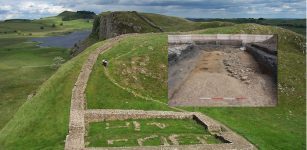Ancient Romans Invented The First Bound Book
AncientPages.com - The history of writing goes very far back in time. In Mesopotamia people wrote on clay tables.
Cuneiform tablets were one of the earliest systems of writing invented by the Sumerians.
The highly controversial Tartaria tablets represent according to some researchers the first writing in the world, which we know of.
The Tartaria tablets which are 1,000 years older than the Mesopotamian writings contain signs that have remained undeciphered until this day.
Even though many ancient civilizations were familiar with writing, it did take some time before bound books appeared. Most ancient civilizations writing was done on heavy clay tablets and unwieldy scrolls.
Ancient Egyptians used Papyrus books in the form of a scroll of several sheets pasted together, for a total length of 10 meters or more. Paper was invented in China around the 1st century AD. The first printing of books started in China and was during the Tang Dynasty (618–907), but exactly when is not known.
Ancient Romans are credited with the invention of bound books. The Roman codex is considered the very first manifestation of the modern-day books.
Ancient Romans streamlined the medium by creating the codex, a stack of bound pages that is recognized as the earliest incarnation of the book. The first codices were made of bound wax tablets, but these were later replaced by animal skin parchment that more clearly resembled pages.
According to ancient historians Julius Caesar created an early version of a codex by stacking pages of papyrus to form a primitive notebook, but bound codices did not become popular in Rome until the first century or thereabouts. Early Christians became some of the first to adopt the new technology, using it extensively to produce copies of the Bible.
AncientPages.com
More From Ancient Pages
-
 Will The Oven Bricks Of The Tudor Warship The Mary Rose Be Preserved Before It’s Too Late?
Artifacts | Apr 7, 2022
Will The Oven Bricks Of The Tudor Warship The Mary Rose Be Preserved Before It’s Too Late?
Artifacts | Apr 7, 2022 -
 Famous Viking Sigurd Snake-In-The-Eye, Son Of Ragnar Lodbrok And The Mark Of Fafnir Prophecy
Featured Stories | Mar 16, 2018
Famous Viking Sigurd Snake-In-The-Eye, Son Of Ragnar Lodbrok And The Mark Of Fafnir Prophecy
Featured Stories | Mar 16, 2018 -
 The Mystery Of Ancient Ever-Burning Lamps
Ancient Technology | Sep 10, 2024
The Mystery Of Ancient Ever-Burning Lamps
Ancient Technology | Sep 10, 2024 -
 North America’s New Snake Species Deepen Our Understanding Of Reptile Social Behavior And Development
Evolution | Aug 2, 2024
North America’s New Snake Species Deepen Our Understanding Of Reptile Social Behavior And Development
Evolution | Aug 2, 2024 -
 Extraordinary Kite-Shaped Pictish Ring Found At Moray Fort In Scotland
Archaeology | Sep 5, 2024
Extraordinary Kite-Shaped Pictish Ring Found At Moray Fort In Scotland
Archaeology | Sep 5, 2024 -
 Does This Cathedral Offer Evidence Our Calendar Is ‘Missing’ 297 Years?
Featured Stories | May 6, 2022
Does This Cathedral Offer Evidence Our Calendar Is ‘Missing’ 297 Years?
Featured Stories | May 6, 2022 -
 ‘The Waters Become Corrupt, The Air Infected’: Here’s How Ancient Greeks And Romans Grappled With Environmental Damage
Featured Stories | Nov 4, 2024
‘The Waters Become Corrupt, The Air Infected’: Here’s How Ancient Greeks And Romans Grappled With Environmental Damage
Featured Stories | Nov 4, 2024 -
 Fantastic Discovery At Hadrian’s Wall Reported By Archaeologists
Archaeology | Sep 10, 2022
Fantastic Discovery At Hadrian’s Wall Reported By Archaeologists
Archaeology | Sep 10, 2022 -
 Ancient DNA Tells Story Of Caribbean’s Early Humans
Archaeology | Dec 28, 2020
Ancient DNA Tells Story Of Caribbean’s Early Humans
Archaeology | Dec 28, 2020 -
 On This Day In History: Eugène Dubois Who Discovered Remains Of Java Man Was Born – On Jan 28, 1858
News | Jan 28, 2017
On This Day In History: Eugène Dubois Who Discovered Remains Of Java Man Was Born – On Jan 28, 1858
News | Jan 28, 2017 -
 Erik The Red: Famous Viking Outlaw Who Colonized Greenland And Was Father Of Leif Erikson
Featured Stories | Jun 16, 2020
Erik The Red: Famous Viking Outlaw Who Colonized Greenland And Was Father Of Leif Erikson
Featured Stories | Jun 16, 2020 -
 Dunstanburgh Castle: Underground Passageways And The Legend Of Sir Guy The Seeker
Featured Stories | Apr 5, 2016
Dunstanburgh Castle: Underground Passageways And The Legend Of Sir Guy The Seeker
Featured Stories | Apr 5, 2016 -
 Michelangelo’s Hidden Secrets Under The Medici Chapel
Featured Stories | Jul 16, 2019
Michelangelo’s Hidden Secrets Under The Medici Chapel
Featured Stories | Jul 16, 2019 -
 When And Why Negev Highlands’ Agricultural Settlement Was Abandoned? – Researchers Have Answers
Archaeology | Jul 28, 2020
When And Why Negev Highlands’ Agricultural Settlement Was Abandoned? – Researchers Have Answers
Archaeology | Jul 28, 2020 -
 On This Day In History: Independence Of Greece Is Recognized By The Treaty Of London – On May 7, 1832
News | May 7, 2016
On This Day In History: Independence Of Greece Is Recognized By The Treaty Of London – On May 7, 1832
News | May 7, 2016 -
 The ‘Band Of Peace’ And Ancient Egyptian Technology – Is It Possible These Sites Were Power Generators?
Ancient Technology | Mar 19, 2017
The ‘Band Of Peace’ And Ancient Egyptian Technology – Is It Possible These Sites Were Power Generators?
Ancient Technology | Mar 19, 2017 -
 Jörmungandr – Hideous Poison-Spewing Midgard Serpent Was One Of Loki’s Children
Featured Stories | Mar 31, 2018
Jörmungandr – Hideous Poison-Spewing Midgard Serpent Was One Of Loki’s Children
Featured Stories | Mar 31, 2018 -
 Did Mastermind Imhotep Receive Sacred Knowledge From Followers Of Horus At Heliopolis?
Featured Stories | Feb 7, 2018
Did Mastermind Imhotep Receive Sacred Knowledge From Followers Of Horus At Heliopolis?
Featured Stories | Feb 7, 2018 -
 On This Day In History: Sir Thomas Brisbane, Astronomer, Soldier And Governor Was Born – On July 23, 1773
News | Jul 23, 2016
On This Day In History: Sir Thomas Brisbane, Astronomer, Soldier And Governor Was Born – On July 23, 1773
News | Jul 23, 2016 -
 Mystery Of Ancient Sami People Buried Underwater – New DNA Breakthrough
Archaeology | Jun 12, 2019
Mystery Of Ancient Sami People Buried Underwater – New DNA Breakthrough
Archaeology | Jun 12, 2019

